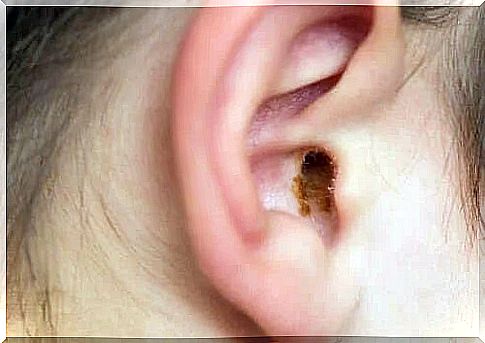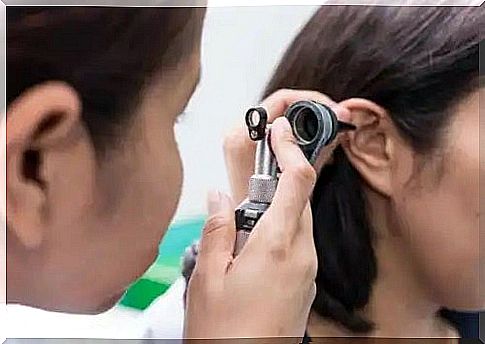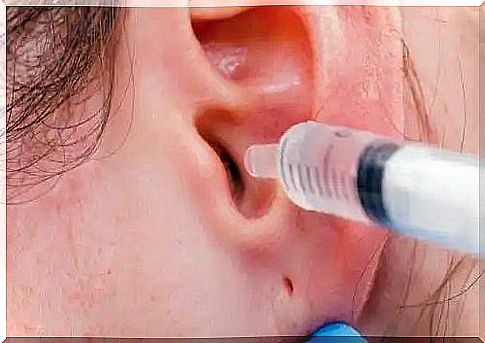Treatment Of Ear Wax Plugs

The creation of the earwax is one of the many defense mechanisms of the human body against foreign agents. Wax plays a key role in protecting and hydrating the ears. But this substance often accumulates and leads to blockages. Read on to find out what is the treatment for wax plugs!
Wax or cerumen is a yellowish-orange substance resulting from the secretions of the sebaceous and sweat glands. It helps to lubricate and clean the human ear, as well as to protect it. It is part of the removal process to replace the superficial cells of the skin by moving the jaw and head.
In some people, the secretion accumulates deep in the ear, leading to the formation of wax plugs. The most common symptom is hearing loss on the affected side. However, early diagnosis and prompt treatment can alleviate the problem.
Symptoms of ear plugs
This is quite annoying and can profoundly affect a person’s quality of life. Estimates indicate that this condition, along with otitis media and external, are the leading causes of hearing loss in young patients.
Affected people experience from hearing difficulties to distant sounds, to total blockage of hearing in the obstructed ear. Patients with earwax plugs often have the following symptoms:
When should you see a doctor?
Seek specialist medical help whenever you have unpleasant or strange symptoms that affect your daily life. Doctors are qualified to assess the health of the ear through a comprehensive examination of the ear canal.
It is important to consult a specialist as soon as possible. Timely treatment can change the prognosis of this condition. In addition, do not try to remove ear wax on your own or using traditional methods. These situations increase the risk of complications.

Causes of ear plugs
The presence of wax in the ear is normal and is part of the physiology of the human body. It disappears on its own as a result of the movements of the jaw that we make when we chew, talk and move our head and with the change of the superficial epithelium of the skin.
Wax plugs occur due to factors that increase production or prevent it from leaking. In addition, the main associated mechanism is the use of ear sticks or hairpins as part of daily hygiene.
Ear sticks move the wax distributed in the ear canal to the back and can even cause damage to this structure. In addition, wax blockage also occurs due to the presence of hearing aids, hearing aids and earplugs.
Moreover, studies show that as a person ages, the serous and sweat glands atrophy and produce a drier wax, which tends to accumulate. Similarly, some patients with developmental disabilities have hypoplastic or smaller ducts, which prevent the natural leakage of wax.
Diagnosis and treatment of wax plugs
A general practitioner or otolaryngologist can easily diagnose the impact of earwax using an otoscope. This portable device uses a light beam and a magnifying glass to visualize the inside of the ear canal.
Examination of the ear with this instrument is known as otoscopy. The doctor inserts a small cone into the opening of the ear, which facilitates the diagnosis of lesions. Once he sees the obstruction, the specialist can use the following medical procedures to remove the earwax:
Prevention and recommendations regarding earplugs
Do not use chopsticks or paper clips inside the ear canal! Use them only for external cleaning of the ear. Reduce the use of headphones.
Professionals recommend the prophylactic application of natural oils or alcohol of 70% concentration if you are prone to this condition, under strict medical supervision. In addition, patients with recurrent problems should visit their doctor every 6 months to assess the health of both ears.
We must also emphasize that specialized sanitation prevents the occurrence of new episodes. The specialist can indicate prophylactic treatment. In addition, there are ways to remove the wax safely and without causing ear damage.

There is currently a long list of alternative procedures for removing wax plugs. Most are based on the use of heat generated by candles or other tools that extract wax.
These methods are risky and associated with burns and even perforations of the ear canal. Consult a doctor in a timely manner if you suspect you have a wax plug. The doctor can quickly identify and address the pathology and can offer you the correct treatment.









